python








JSON Python의 은(는) 네트워크를 통한 텍스트 형식으로 데이터 교환 및 데이터 전송을 위한 JavaScript에서 영감을 받은 표준 형식입니다. 일반적으로 JSON은 문자열 또는 텍스트 형식입니다. API 및 데이터베이스에서 사용할 수 있으며 개체를 이름/값 쌍으로 나타냅니다. JSON은 JavaScript Object Notation의 약자입니다.
Python JSON 구문:
JSON은 키와 값 쌍으로 작성됩니다.
{
"Key": "Value",
"Key": "Value",
}
JSON은 과(와) 매우 유사합니다. 파이썬 사전. Python은 JSON을 지원하며 JSON으로 라이브러리가 내장되어 있습니다.
'마샬 ' 및 '피클' Python의 외부 모듈은 JSON 버전을 유지합니다. 파이썬 라이브러리. 인코딩 및 디코딩과 같은 JSON 관련 작업을 수행하기 위해 Python에서 JSON을 사용하려면 먼저 가져오기 가 필요합니다. JSON 라이브러리 및 이에 대한 .py 파일,
import json
JSON Python 모듈에서 사용할 수 있는 메서드는 다음과 같습니다.
| 메소드 | 설명 |
|---|---|
| 덤프() | JSON 객체로 인코딩 |
| 덤프() | 파일에 인코딩된 문자열 쓰기 |
| 로드() | JSON 문자열 디코딩 |
| 로드() | JSON 파일을 읽는 동안 디코딩 |
Python의 JSON 라이브러리는 기본적으로 다음과 같은 Python 개체를 JSON 개체로 변환합니다.
| 파이썬 | JSON |
|---|---|
| 딕셔너리 | 개체 |
| 목록 | 배열 |
| 유니코드 | 문자열 |
| 숫자 – int, long | 숫자 – 정수 |
| 플로트 | 숫자 – 실수 |
| 사실 | 사실 |
| 거짓 | 거짓 |
| 없음 | 널 |
Python 데이터를 JSON으로 변환하는 것을 인코딩 작업이라고 합니다. 인코딩은 JSON 라이브러리 메서드인 dumps()를 사용하여 수행됩니다.
json.dumps() Python에서 는 Python의 사전 개체를 JSON 문자열 데이터 형식으로 변환하는 메서드입니다. 구문 분석, 인쇄 등과 같은 작업을 위해 개체가 문자열 형식이어야 할 때 유용합니다.
이제 Python으로 첫 번째 json.dumps 인코딩 예제를 수행해 보겠습니다.
import json
x = {
"name": "Ken",
"age": 45,
"married": True,
"children": ("Alice","Bob"),
"pets": ['Dog'],
"cars": [
{"model": "Audi A1", "mpg": 15.1},
{"model": "Zeep Compass", "mpg": 18.1}
]
}
# sorting result in asscending order by keys:
sorted_string = json.dumps(x, indent=4, sort_keys=True)
print(sorted_string)
출력:
{"person": {"name": "Kenn", "sex": "male", "age": 28}})
동일한 함수 dump()를 사용하여 사전의 JSON 파일을 생성하기 위해 Python이 파일에 JSON을 작성하는 예를 살펴보겠습니다.
# here we create new data_file.json file with write mode using file i/o operation
with open('json_file.json', "w") as file_write:
# write json data into file
json.dump(person_data, file_write)
출력:
표시할 항목이 없습니다... 시스템에 json_file.json이 생성됩니다. 아래의 write JSON to file Python 예제와 같이 해당 파일을 확인할 수 있습니다.

JSON 문자열 디코딩은 내장 메소드 json.loads()를 사용하여 수행됩니다. &json.load() Python의 JSON 라이브러리. 다음 번역 테이블은 JSON 문자열의 Python에서 디코딩을 수행하는 데 도움이 되는 Python 개체에 대한 JSON 개체의 예를 보여줍니다.
| JSON | 파이썬 |
|---|---|
| 객체 | 딕셔너리 |
| 배열 | 목록 |
| 문자열 | 유니코드 |
| 숫자 – 정수 | 숫자 – 정수, 긴 |
| 숫자 – 실수 | 플로트 |
| 사실 | 사실 |
| 거짓 | 거짓 |
| 널 | 없음 |
json.loads를 사용하여 디코딩하는 기본 구문 분석 JSON Python 예제를 살펴보겠습니다. 기능,
import json # json library imported
# json data string
person_data = '{ "person": { "name": "Kenn", "sex": "male", "age": 28}}'
# Decoding or converting JSON format in dictionary using loads()
dict_obj = json.loads(person_data)
print(dict_obj)
# check type of dict_obj
print("Type of dict_obj", type(dict_obj))
# get human object details
print("Person......", dict_obj.get('person'))
출력:
{'person': {'name': 'Kenn', 'sex': 'male', 'age': 28}}
Type of dict_obj <class 'dict'>
Person...... {'name': 'John', 'sex': 'male'}
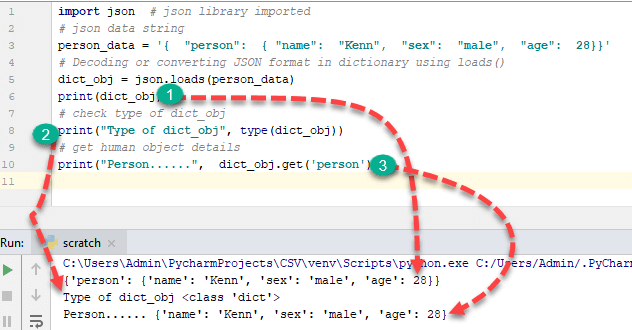
이제 Python parse JSON 예제를 사용하여 Python에서 JSON 파일을 읽는 방법을 배웁니다.
참고: JSON 파일 디코딩은 File Input/Output(I/O) 관련 작업입니다. JSON 파일은 프로그램에서 언급한 지정된 위치의 시스템에 있어야 합니다.
Python 읽기 JSON 파일 예:
import json
#File I/O Open function for read data from JSON File
with open('X:/json_file.json') as file_object:
# store file data in object
data = json.load(file_object)
print(data)
여기 데이터 위의 읽기 JSON 파일 Python 예제와 같이 Python의 사전 객체입니다.
출력:
{'person': {'name': 'Kenn', 'sex': 'male', 'age': 28}} 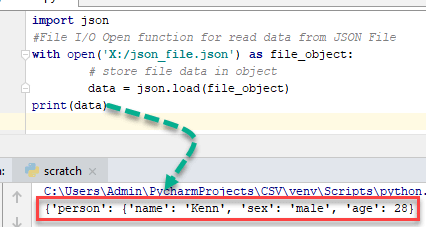
JSON 파일의 크기를 줄여야 하는 경우 Python에서 압축 인코딩을 사용할 수 있습니다.
예,
import json
# Create a List that contains dictionary
lst = ['a', 'b', 'c',{'4': 5, '6': 7}]
# separator used for compact representation of JSON.
# Use of ',' to identify list items
# Use of ':' to identify key and value in dictionary
compact_obj = json.dumps(lst, separators=(',', ':'))
print(compact_obj)
출력:
'["a", "b", "c", {"4": 5, "6": 7}]'
** Here output of JSON is represented in a single line which is the most compact representation by removing the space character from compact_obj ** 예:
import json
dic = { 'a': 4, 'b': 5 }
''' To format the code use of indent and 4 shows number of space and use of separator is not necessary but standard way to write code of particular function. '''
formatted_obj = json.dumps(dic, indent=4, separators=(',', ': '))
print(formatted_obj)
출력:
{
"a" : 4,
"b" : 5
}
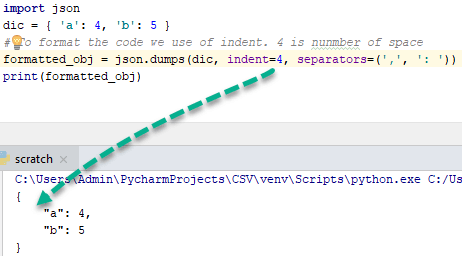
이것을 더 잘 이해하려면 들여쓰기를 40으로 변경하고 출력을 관찰하십시오-
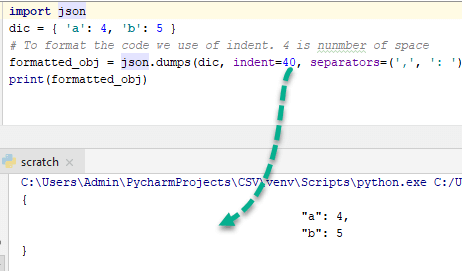
JSON 코드 주문:
정렬 키 Python 덤프 함수의 인수에 있는 속성은 JSON의 키를 오름차순으로 정렬합니다. sort_keys 인수는 부울 속성입니다. 정렬이 허용되면 그렇지 않으면 허용되지 않습니다. Python string to JSON 정렬 예제로 이해합시다.
예,
import json
x = {
"name": "Ken",
"age": 45,
"married": True,
"children": ("Alice", "Bob"),
"pets": [ 'Dog' ],
"cars": [
{"model": "Audi A1", "mpg": 15.1},
{"model": "Zeep Compass", "mpg": 18.1}
],
}
# sorting result in asscending order by keys:
sorted_string = json.dumps(x, indent=4, sort_keys=True)
print(sorted_string)
출력:
{
"age": 45,
"cars": [ {
"model": "Audi A1",
"mpg": 15.1
},
{
"model": "Zeep Compass",
"mpg": 18.1
}
],
"children": [ "Alice",
"Bob"
],
"married": true,
"name": "Ken",
"pets": [
"Dog"
]
}
키 나이를 보시면 알겠지만 자동차, 어린이 등이 오름차순으로 정렬되어 있습니다.
복잡한 개체에는 다음과 같은 두 가지 부분이 있습니다.
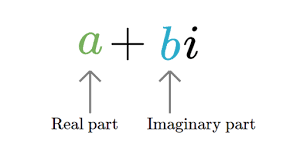
예:3 +2i
복잡한 객체의 인코딩을 수행하기 전에 변수가 복잡한지 여부를 확인해야 합니다. 인스턴스 메소드를 사용하여 변수에 저장된 값을 확인하는 함수를 만들어야 합니다.
객체가 복잡하거나 인코딩에 적합한 검사를 위한 특정 함수를 만들어 보겠습니다.
import json
# create function to check instance is complex or not
def complex_encode(object):
# check using isinstance method
if isinstance(object, complex):
return [object.real, object.imag]
# raised error using exception handling if object is not complex
raise TypeError(repr(object) + " is not JSON serialized")
# perform json encoding by passing parameter
complex_obj = json.dumps(4 + 5j, default=complex_encode)
print(complex_obj)
출력:
'[4.0, 5.0]'
JSON에서 복잡한 객체를 디코딩하려면 JSON 문자열에 복잡한 객체가 포함되어 있는지 확인하는 object_hook 매개변수를 사용합니다. JSON Python 예제에 문자열로 이해하자,
import json
# function check JSON string contains complex object
def is_complex(objct):
if '__complex__' in objct:
return complex(objct['real'], objct['img'])
return objct
# use of json loads method with object_hook for check object complex or not
complex_object =json.loads('{"__complex__": true, "real": 4, "img": 5}', object_hook = is_complex)
#here we not passed complex object so it's convert into dictionary
simple_object =json.loads('{"real": 6, "img": 7}', object_hook = is_complex)
print("Complex_object......",complex_object)
print("Without_complex_object......",simple_object)
출력:
Complex_object...... (4+5j)
Without_complex_object...... {'real': 6, 'img': 7}
JSONEncoder 클래스는 인코딩을 수행하는 동안 모든 Python 개체의 직렬화에 사용됩니다. 여기에는 세 가지 다른 인코딩 방법이 포함되어 있습니다.
JSONEncoder 클래스의 encode() 메서드를 사용하여 아래 Python JSON 인코더 예제와 같이 모든 Python 객체를 인코딩할 수도 있습니다.
# import JSONEncoder class from json
from json.encoder import JSONEncoder
colour_dict = { "colour": ["red", "yellow", "green" ]}
# directly called encode method of JSON
JSONEncoder().encode(colour_dict)
출력:
'{"colour": ["red", "yellow", "green"]}' JSONDecoder 클래스는 디코딩을 수행하는 동안 모든 Python 개체의 직렬화 해제에 사용됩니다. 여기에는 세 가지 디코딩 방법이 포함되어 있습니다.
JSONDecoder 클래스의 decode() 메서드를 사용하여 아래 Python JSON 디코더 예제와 같이 JSON 문자열을 디코딩할 수도 있습니다.
import json
# import JSONDecoder class from json
from json.decoder import JSONDecoder
colour_string = '{ "colour": ["red", "yellow"]}'
# directly called decode method of JSON
JSONDecoder().decode(colour_string)
출력:
{'colour': ['red', 'yellow']} 지정된 URL(https://feeds.citibikenyc.com/stations/stations.json)에서 CityBike NYC(자전거 공유 시스템)의 데이터를 가져와 사전 형식으로 변환합니다.
Python 파일에서 JSON 로드 예:
참고:- Python에 요청 라이브러리가 이미 설치되어 있는지 확인하고 그렇지 않은 경우 터미널 또는 CMD를 열고
를 입력합니다.import json
import requests
# get JSON string data from CityBike NYC using web requests library
json_response= requests.get("https://feeds.citibikenyc.com/stations/stations.json")
# check type of json_response object
print(type(json_response.text))
# load data in loads() function of json library
bike_dict = json.loads(json_response.text)
#check type of news_dict
print(type(bike_dict))
# now get stationBeanList key data from dict
print(bike_dict['stationBeanList'][0])
출력:
<class 'str'>
<class 'dict'>
{
'id': 487,
'stationName': 'E 20 St & FDR Drive',
'availableDocks': 24,
'totalDocks': 34,
'latitude': 40.73314259,
'longitude': -73.97573881,
'statusValue': 'In Service',
'statusKey': 1,
'availableBikes': 9,
'stAddress1': 'E 20 St & FDR Drive',
'stAddress2': '',
'city': '',
'postalCode': '',
'location': '',
'altitude': '',
'testStation': False,
'lastCommunicationTime': '2018-12-11 10:59:09 PM', 'landMark': ''
}
Python 파일에서 JSON 로드 예:
import json
#File I/O Open function for read data from JSON File
data = {} #Define Empty Dictionary Object
try:
with open('json_file_name.json') as file_object:
data = json.load(file_object)
except ValueError:
print("Bad JSON file format, Change JSON File")
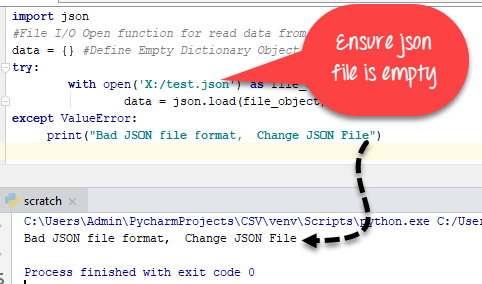
JSON 데이터 교환 형식(RFC – Request For Comments)은 Infinite 또는 Nan Value를 허용하지 않지만 Python-JSON 라이브러리에서 Infinite 및 Nan Value 관련 작업을 수행하는 데 제한이 없습니다. JSON이 INFINITE 및 Nan 데이터 유형을 가져오면 리터럴로 변환됩니다.
예,
import json
# pass float Infinite value
infinite_json = json.dumps(float('inf'))
# check infinite json type
print(infinite_json)
print(type(infinite_json))
json_nan = json.dumps(float('nan'))
print(json_nan)
# pass json_string as Infinity
infinite = json.loads('Infinity')
print(infinite)
# check type of Infinity
print(type(infinite))
출력:
Infinity <class 'str'> NaN inf <class 'float'>
RFC는 키 이름이 JSON 개체에서 고유해야 한다고 지정하지만 필수는 아닙니다. Python JSON 라이브러리는 JSON에서 반복되는 객체의 예외를 발생시키지 않습니다. 반복되는 모든 키-값 쌍을 무시하고 그 중 마지막 키-값 쌍만 고려합니다.
import json
repeat_pair = '{"a": 1, "a": 2, "a": 3}'
json.loads(repeat_pair)
출력:
{'a': 3} json.tool JSON pretty-print 구문의 유효성을 검사하는 명령줄 인터페이스를 제공합니다. CLI의 예를 살펴보겠습니다.

$ echo '{"name" : "Kings Authur" }' | python3 -m json.tool 출력:
{
"name": " Kings Authur "
}
| 파이썬 JSON 함수 | 설명 |
|---|---|
| json.dumps(person_data) | JSON 객체 생성 |
| json.dump(person_data, file_write) | Python의 File I/O를 이용한 JSON 파일 생성 |
| compact_obj =json.dumps(데이터, 구분 기호=(',',':')) | 구분 기호를 사용하여 JSON 개체에서 공백 문자를 제거하여 JSON 개체 압축 |
| formatted_obj =json.dumps(dic, indent=4, separators=(',', ':')) | 들여쓰기를 사용하여 JSON 코드 형식 지정 |
| sorted_string =json.dumps(x, 들여쓰기=4, sort_keys=True) | 알파벳 순서로 JSON 객체 키 정렬 |
| complex_obj =json.dumps(4 + 5j, 기본값=complex_encode) | JSON의 Python 복합 객체 인코딩 |
| JSONEncoder().encode(color_dict) | 직렬화를 위한 JSONEncoder 클래스 사용 |
| json.loads(data_string) | json.loads() 함수를 사용하여 Python 사전에서 JSON 문자열 디코딩 |
| json.loads('{"__complex__":true, "실제":4, "img":5}', object_hook =is_complex) | 복잡한 JSON 객체를 Python으로 디코딩 |
| JSONDecoder().decode(color_string) | 역직렬화를 통해 JSON을 Python으로 디코딩 사용 |
python
XML이란 무엇입니까? XML은 eXtensible Markup Language의 약자입니다. 중소량의 데이터를 저장 및 전송하도록 설계되었으며 구조화된 정보를 공유하는 데 널리 사용됩니다. Python을 사용하면 XML 문서를 구문 분석하고 수정할 수 있습니다. XML 문서를 구문 분석하려면 전체 XML 문서가 메모리에 있어야 합니다. 이 튜토리얼에서는 Python에서 XML minidom 클래스를 사용하여 XML 파일을 로드하고 구문 분석하는 방법을 살펴봅니다. 이 튜토리얼에서 배울 것입니다- minidom을 사용하여 X
이 문서에서는 gRPC를 사용하는 AXC F 3152를 사용하여 Python으로 간단한 프로세스 데이터에 액세스하고 쓰는 방법을 설명합니다. (https://www.plcnext.help/te/Service_Components/gRPC_Introduction.htm) 전제조건 먼저 PLC 외부(예:Windows 시스템)에서 필요한 파일을 준비해야 합니다. Python 3.9 설치(3.10에서는 오류가 발생할 수 있음) .proto 파일에서 코드를 생성하는 데 필요한 Python 패키지 설치:pip install grpcio-to